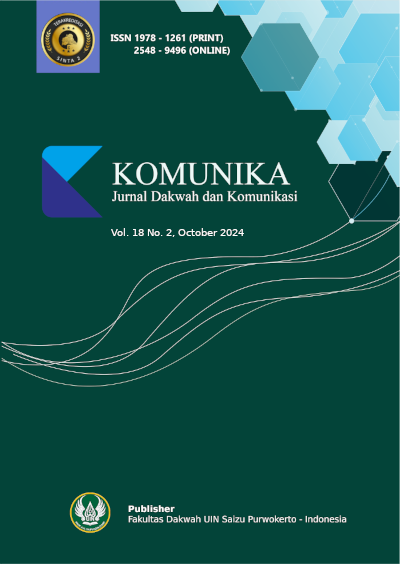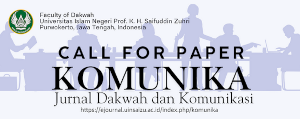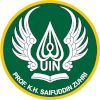Progressive Women's Da'wah Movement in Southeast Sulawesi, Indonesia
DOI:
https://doi.org/10.24090/komunika.v18i2.9659Keywords:
Da’wah Movement, Progressive Women, Southeast SulawesiAbstract
This research aims to explain the pattern of the Aisyiyah Da'wah Movement in Southeast Sulawesi and how Aisyiyah's strategy manages opportunities and mobilizes her strength to realize the ideals of its da'wah movement. This research data was obtained through in-depth interviews, observation, and document review. In-depth interviews were conducted with female Muhammadiyah figures in Southeast Sulawesi. Observations were used to observe the da'wah activities female Muhammadiyah figures carried out. All data were analyzed using the Miles and Huberman paradigm. Based on the data and analysis carried out, the following conclusions were obtained: Aisyiyah's da'wah movement was carried out in two patterns, namely: (1). Da'wah in the form of tabligh, namely transmitting Islamic teachings verbally (lectures) both offline and online and through writing in the form of distributing brochures, magazines containing religious understanding from a Muhammadiyah perspective. In its implementation, tabligh in the form of recitation is mainly carried out in the internal environment. In contrast, tabligh, in the sense of the involvement of Aisyiyah figures in providing recitations in mosques and majlis taklim, has not been touched by Aisyiyah. (b) Da'wah bi al-hal, namely an approach that integrates da'wah with social and humanitarian action. The phenomenon can be seen in Aisyiyah's active involvement in tackling TB and the Covid-19 outbreak. Aisyiyah also integrates da'wah into the learning system in the schools and universities she owns. The Southeast Sulawesi Aisyiyah da'wah movement through educational institutions is quite progressive.Downloads
References
Alifuddin, M. (2022). Istek Aisyiyah: Aktualisasi Pemikiran Progresif Komunitas Perempuan Southeast Sulawesi, Jurnal Pemerintahan dan Kebijakan, 4(1).
Alifuddin, M. (2019). “Islam Berkemajuan (Telaah Historis Gerakan Sosial Budaya Muhammadiyah di Sulawesi-Tenggara)”, Laporan Penelitian, LPPM IAIN.
Alifuddin, M. (2021). Muhammadiyah Sebagai Gerakan Pendidikan: Sejarah Eksistensi Perguruan Tinggi Muhammadiyah di Sulawesi Tenggara. Al-Ta’dib, 14(1).
Alifuddin, M. (2022). Deskripsi Analitik atas Gerak Pertumbuhan dan Perkembangan Institusi Pendidikan Tinggi Muhammadiyah di Sulawesi Tenggara. Sang Pencerah, 8(1).
Almasri, M. N. (2013). Impressum. European Journal of Immunology, 43(10), 2783–2783. https://doi.org/10.1002/eji.201370106
Anggriani, M., Sumanti, S. T., & Syam, A. M. (2024). Perkembangan Muhammadiyah di Kabupaten Aceh Tenggara, 1955-2022. MUKADIMAH: Jurnal Pendidikan, Sejarah, Dan Ilmu-Ilmu Sosial, 8(1), 68–76.
Azizah, N., Tampubolon, A. P., & Sibarani, H. S. (2021). KOMUNIKASI ORGANISASI: Kepemimpinan dan Gaya Kepemimpinan: Komunikasi Organisasi, Kepemimpinan, Jenis Kepemimpinan, Gaya Kepemimpinan. KomunikA, 17(1).
Benfoord. (2000). Robert "Framing Process and Social Movements: An Overview and Assessment" dalam Annual Review of Sociology.
Burdah, L. T. Y. A. Z. (2022). Manajemen Dakwah Nasyiatul Aisyiyah adlam Meningkatkan Kualitas Keberagamaan Kaum Perempuan (Study terhadap Gerakan Nasyiatul Aisyiyah Muhammadiyah PD Kota Bandar Lampung). Universitas Islam Negeri Raden Intan Lampung.
Datin, R. (2022). Advokasi Organisasi Aisyiyah Jawa Timur Terhadap Kasus Kekerasan Seksual. Al Maqashidi, 5(1), 1–18. https://ejournal.sunan-giri.ac.id/index.php/almaqashidi/article/download/607/405
Hadisaputra, H., Damayanti, E., Quraisy, H., & Lukman, L. (2022). Dinamika Gerakan Perempuan Berkemajuan di Tingkat Lokal (Sejarah ‘Aisyiyah Sulawesi Selatan Tahun 1927-1965). Edukatif: Jurnal Ilmu Pendidikan, 4(2), 1717–1728.
Hadisaputro. (2021). Paradigma Gender dan Model Gerakan Aisyiyah Sulawesi Selatan Pada Masa Orde Baru. Mukaddimah, 5.
Handayani, D. W. (2019). Kajian Peluang Pimpinan Wilayah Nasyiatul Aisyiyah Lampung dalam Pencegahan Kerentanan Perempuan pada Kejahatan Narkoba. Prosiding Seminar Nasional FISIP Universitas Lampung (SeFila) 3’Agenda Baru Pembangunan Indonesia Berbasis Local Knowledge’, Kamis, 8 Agustus 2019, Hotel Bukit Randu, Kota Bandarlampung, Indonesia, 3, 43–48.
Hasmiati, dkk. (2021). Dakwah Aisyiyah melalui kader Tuberkulosis (Tb) care di Kabupaten Sinjai. Jurnal Ilmu Dakwah, 41(1).
Kriesi, H. (2004). Political Context and Opportunity, dalam Blackwel Companion to Social Movements. Balckwell Publishing.
Kusumah, W., & Alawiyah, T. (2021). Guru Penggerak: Mendorong Gerak Maju Pendidikan Nasional. Penerbit Andi.
Mir’atunnisa, F. (2020). Peranan Aisyiyah dalam Bidang Pendidikan Anak Usia Dini i Kota Semarang pada 1967-2015. Historiografi, 1(1).
Moleong, L. J. (2014). Metode Penelitian Kualitatif. Rosdakarya.
Nakamura, M. (1983). Bulan Sabit Muncul dari Balik Pohon Bringin. Gajah Mada Unirversity Press.
Nasution, H. (n.d.). Studi Pemikiran Siti Walidah (Nyai Akhmad Dahlan) Dalam Pendidikan Perempuan. Jurnal Pendidikan Bahasa dan Sastra Arab.
Naufal, M. Z., & Jinan, M. (2022). Implementasi Teologi Al-Ma’un Di Madrasah Aliyah Muhammadiyah Batang. Universitas Muhammadiyah Surakarta.
Nisa, E. A. (2022). Pandangan dan Peran Organisasi Aisyiyah terhadap Pendidikan di Indonesia Tahun 1914-1923. Warisan: Journal of History and Cultural Heritage, 3(2), 51–57.
No Title. (n.d.). http://ensiklopedia.kemdikbud.go.id/sastra/artikel/Ahmad_Tohari
Nuraeni, D. S. (2013). Corak Pemikiran dan Gerakan Akstivis Perempuan (Melacak Pandangan Kegamaan Aisyiyah Periode 1917-1945. Profetika, 14(2).
Peacock, J. L. (1968). Purifying the Faith: The Muhammadiyah Movement in Indonesian Islam, terj. Suara Muhammadiyah.
Pranawati, R. (2019). Filantropi untuk Keadilan Sosial Aisyiyah.
Remiswal. (2021). Aisyiyah dan Peranannya Dalam Meningkatkan Derajat Keperempuanan, Jurnal Pendidikan Sejarah dan Riset Sosial Humaniora (Kaganga. Pendidikan Sejarah Dan Riset Sosial Humaniora, 4(1).
Rof'ah. (2016). Posisi dan Jati Diri Aisyiyah, Perubahan dan Perkembangan. Suara Muhammadiyah.
Saefudin, S. (2022). Transformasi Doktrin Al-Ma’un Terhadap Penguatan Gerakan Ekonomi Muhammadiyah. Jurnal Ilmiah Ekonomi Islam, 8(2), 2120–2134.
Samsidar, D. (2021). Dakawah Aisyiyah dalam Pembinaan Keluarga Sakinah, al-Muaddib. Al-Muaddib, 6(2).
Snow, D. (2004). Framing Process, Ideology and Discursive Fileds dalam Blackwel Companion to Social Movement Massachusets. Balckwell Publishing.
Susanto, D. (2013). Gerakan Dakwah Aktivis Perempuan ‘Aisyiyah Jawa Tengah. Sawwa: Jurnal Studi Gender, 8(2), 323. https://doi.org/10.21580/sa.v8i2.660
Wictorowicz. (2006). Quintan “Anatomy of the Salafi Movement” , dalam Jurnal Studies in Conflict an Terrorism. Studies in Conflict an Terrorism, 29.
Yuristiadi, G. (2015). Aktivisme Hoofdbestuur Muhammadiyah Bagian PKO di Yogyakarta Sebagai Representasi Gerakan Pelayanan Sosial Masyarakat Sipil (1920-1931)”. Afkaruna, 11(2).
Yusuf. (2022). Dakwah Perempuan: Pemberdayaan Perempuan Muhammadiyah Sulawesi Tenggara (Vol. 13, p. 2).
Downloads
Published
Issue
Section
License
Copyright (c) 2024 Muhammad Alifuddin, Kholil Lur Rochman, Uswatun Hasanah, Wahyu Budiantoro

This work is licensed under a Creative Commons Attribution-ShareAlike 4.0 International License.
Authors who publish with this journal agree to the following terms:
- Authors retain copyright and grant the journal right of first publication with the work simultaneously licensed under a Creative Commons Attribution-ShareAlike 4.0 International License that allows others to share the work with an acknowledgement of the work's authorship and initial publication in this journal.
- Authors are able to enter into separate, additional contractual arrangements for the non-exclusive distribution of the journal's published version of the work (e.g., post it to an institutional repository or publish it in a book), with an acknowledgement of its initial publication in this journal.
- Authors are permitted and encouraged to post their work online (e.g., in institutional repositories or on their website) prior to and during the submission process, as it can lead to productive exchanges, as well as earlier and greater citation of published work (See The Effect of Open Access).

























